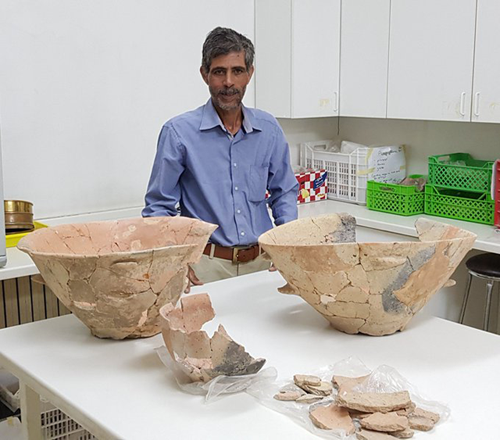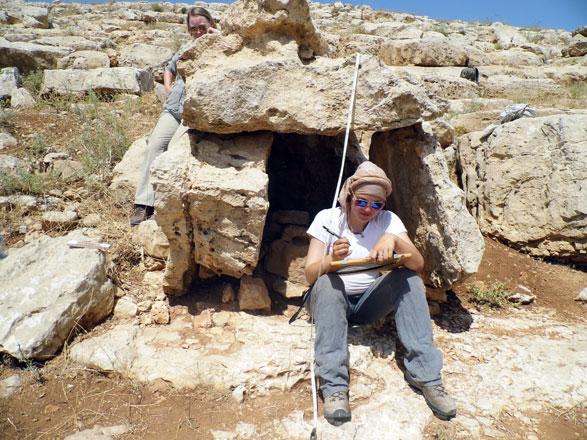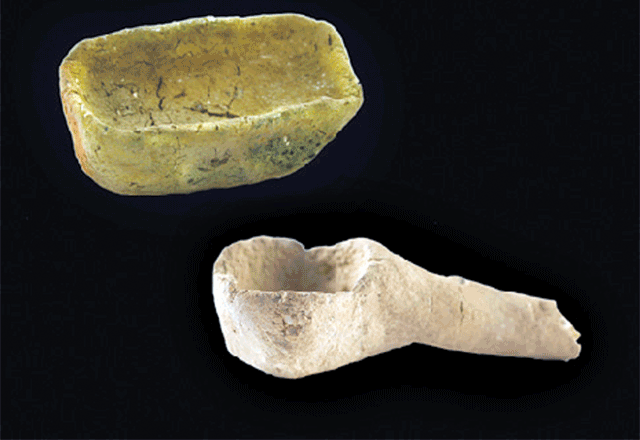You are here
Murayghat attracts local, international archaeologists interested in exploring rich Jordanian heritage
By Saeb Rawashdeh - Jan 09,2024 - Last updated at Jan 10,2024

Conservation Technician Naif Zaban works for the ACOR Conservation Cooperative. Here he is with the Early Bronze Age vessels he conserved from Khirbet Al Murayghat. They were excavated by Dr Susanne Kerner of the University of Copenhagen (Photo courtesy of Barbara Porter)
AMMAN — Murayghat is a Prehistoric site located 3km southwest from Madaba known for the large number of dolmens scattered on its slopes. Popularly called “Jordanian Stonehenge”, Murayghat attracts local and international archaeologists who explore rich Jordanian heritage. Number of hills contain finds from the Late Chalcolithic period to the Early and Middle Bronze Age as well as Islamic period.
While studying dolmens, a team of archaeologists from the University of Copenhagen discovered a badly preserved floor and large pottery vessels that were distributed over the area.
“The largest of these originally standing stones were over 1.2m high, although they are not always rectangular, but display squarish or irregular shapes,” said Susanne Kerner from the University of Copenhagen, adding that in 2019 her team excavated a wall in the eastern side of the site.
Regarding the floor, many more fragments have been found on the floor and just above, which all date into the Early Bronze I period. The Early Bronze period was characterised by the first urban communities and a shift towards sedentary lifestyle.
“The three reconstructed vessels are made from a fabric, which is defined as a middle coarse fabric with a light core colour and a light slip on the exterior surface, tempered with chert, grog and a white mineral,” Kerner underlined, adding that the two vessels are very large.
The vessel is roughly 25cm high and has two sets of two ledge handles above each other. “These handles are set in roughly regular intervals around the body of the vessel [one in every quarter]. The upper ledges are just a few centimetres below the slightly everted rim with a thinning lip and only 5cm long and even less wide.” Kerner explained, noting that the lower ledge handles are around 10cm long, also wider and slightly thumb-impressed.
Second bowl is an even larger, deep and straight-sided vessel, the base is just over 20cm in diameter and the height is around 27cm, the scholar said, explaining that it is slightly oval at the opening, which might be due to the breakage and reconstruction, with a straight rim and a round lip.
“This bowl has two sets of two ledge handles, set alternating with single ledge handles,” Kerner underlined, adding that the bowl shows signs of repairing; as two carefully bored holes are present above one of the single handles.
In addition, the two large Murayghat bowls are very uncommon for their set of double handles as no comparisons currently exist.
Bowls were part of ancient feasting which was an integral part of social interaction of communities that lived at Murayghat.
“The Murayghat bowls indicate most certainly large-scale consumption, as their volume would have allowed feeding of many people, although the exact number would obviously depend on the actual size of the portions,” Kerner speculated, adding that two large vessels could probably hold modest portions of food for around 100 people.
The size of the vessels would also require more than one person to carry them for any distance when full, which might be the explanation behind the double sets of handles. Two persons carrying a bowl need to have a good grip on the vessel and their labourious steps would add an element of performance to the serving, she elaborated.
Rituals are patterned activities or practices oriented towards the control and/or organisation of human affairs and they are primarily symbolic in character and as a socially constructed code. The rite connected with burials would have played a large role at a site that was tightly connected to death and funerals.
“Rituals tend to be staged and performed and often require paraphernalia, the Murayghat bowls might have been exactly that: Paraphernalia for the performance of food related rituals, when secondary burials brought groups of people together to feast,” Kerner concluded.
Related Articles
AMMAN — For some, Murayghat, a site located 3km southwest of Madaba, represents a “Jordanian Stonehenge”, with over 100 dolmens scattered th
AMMAN — Pottery found in Hujayrat Al Ghuzlan, a site located four kilometres north of Aqaba, dates back to between 4,000 and 3,4
AMMAN — A menhir is an upright stone that can be found across the globe: Middle East, Europe, Africa, South America and Asia.




















